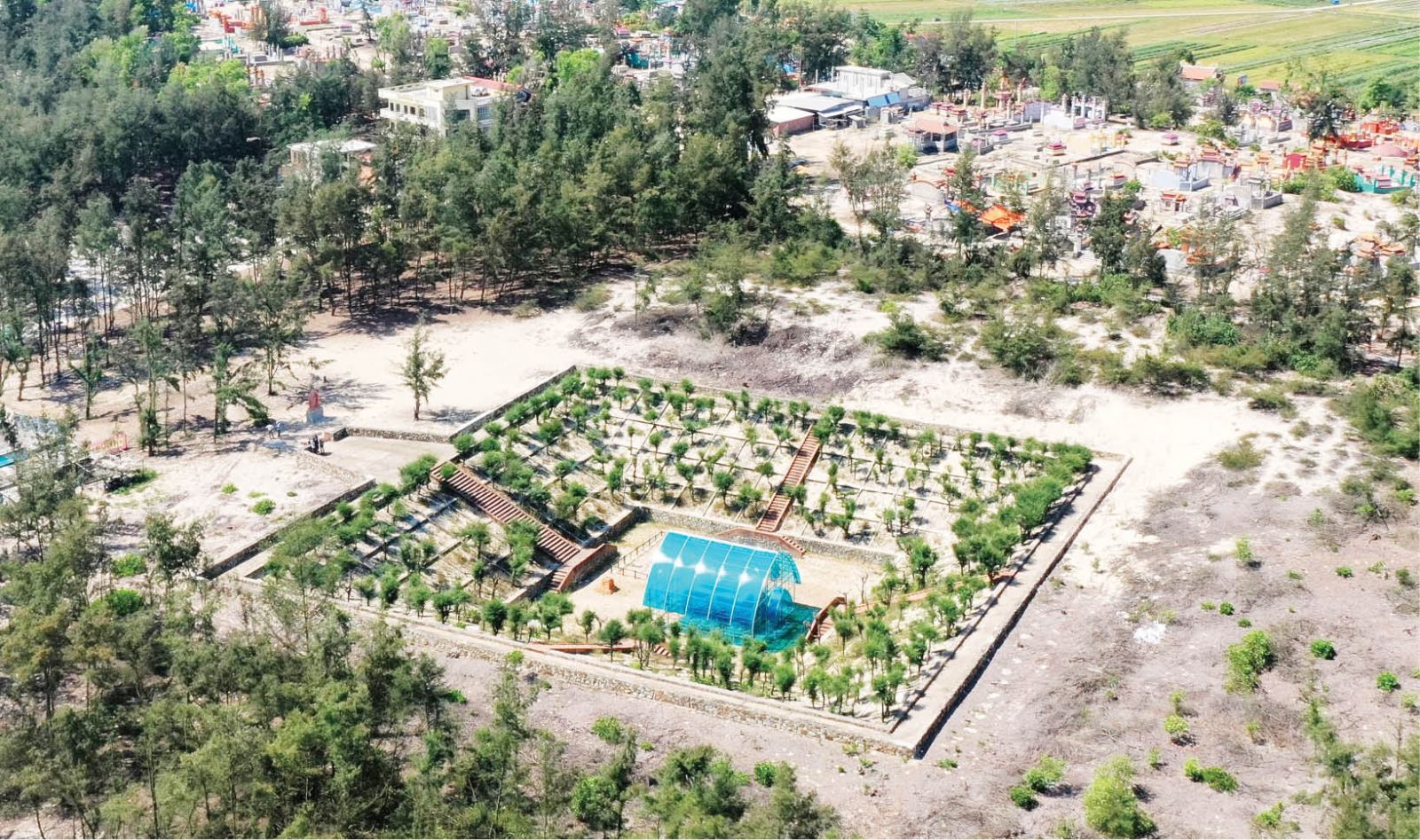Being the “contiguous region” of Vietnam - Champa in history, Thua Thien Hue is a land that preserves many vestiges of Champa culture which reflect artistic uniqueness, genres diversity and aesthetic value of the process of “migration to the South” of Dai Viet people.

Phu Dien Cham Tower (Phu Dien commune, Phu Vang district) seen from above.
Photo: History Museum
Diverse Champa tangible cultural heritages
According to a survey by the Provincial Historical Science Association, there are 44 vestiges of Champa culture in Thua Thien Hue. Among which, there are 17 temples and towers, 3 ramparts as well as many relics such as tombs, steles, ancient wells, etc.
Up to now, there are 3 vestiges classified as national relics including Lieu Coc Twin Towers (Huong Xuan ward, Huong Tra town), Phu Dien Tower (Phu Dien commune, Phu Vang district) and Loi Citadel (located between Thuy Bieu and Thuy Xuan wards, Hue City).
In addition, there are hundreds of artifacts belonging to many categories such as utensils, religious, decorative, and worshipping architecture, etc., which are kept at the Provincial History Museum, Hue Museum of Royal Antiquities; the Faculty of History, University of Science, Hue University; Culture, Information and Sports Center of Hue City; among which, the Van Trach Hoa altar has been recognized as a national treasure.
Mr. Nguyen Xuan Hoa, former Director of the Department of Culture and Information, said that there were very few Champa temples, monuments, and relics in the province at first glance as compared to other southern cities and provinces starting from Quang Nam. But actually, Champa cultural tangible heritages in Hue are incredibly diverse.
According to Mr. Hoa, most of the remaining Champa tangible cultural heritages in Hue do not exist independently as the Cham's own works. Many vestiges and relics of Champa have been received by Hue people and merged with the traditional religious forms of Vietnamese people to create a diverse religious nuance of Hue people.
Many examples are cited by Mr. Hoa, ranging from Linh Thai tower relic, which was transformed into Tran Hai pagoda, Uu Diem tower, which was turned into Phat Loi pagoda, Van Trach Hoa tower, which was converted into Ba Loi pagoda, etc.
In particular, it is impossible not to mention the temple of Goddess Po Yang Inu Nagar - the mother of Cham people in Hon Chen mountain, which has been transformed into a shrine to the goddess Thien Y A Na, once named as Hue Nam Palace by Emperor Dong Khanh. Not only that, the forms of beliefs, cuisines, costumes, etc., of Hue people are also influenced in some aspects of Cham people’s lives.
From another perspective, Dr. Nguyen Van Quang, Deputy Dean of Faculty of History, University of Science, Hue University, said that the development of Champa in Thua Thien Hue area was not only reflected in the number of vestiges and relics but also through their diversity.
It is possible to recognize the presence of all types of Champa relics, such as temples - towers, citadel - ramparts, wells, inscriptions, graves and sculptures.
“This reflects the diversity of life, from material to spiritual, from civilian to military. These types of monuments are often concentrated in clusters or groups, densely located in the plains, the middle and downstream of the major rivers of the region and surrounding a citadel,” said Dr. Quang.
Not “unified”
Nguyen Xuan Hoa, the researcher, affirmed that the underlying value of Cham heritage, despite not being kept intact, has blended in Hue's consciousness; a large part of which is integrated with Hue culture, creating the cultural identity of Hue.
“It's time to look back at the true values of this heritage in order to preserve, promote, and develop the unique values that Champa cultural heritage has contributed to Hue,” suggested Mr. Hoa.
According to Dr. Phan Tien Dung, Chairman of the Provincial Historical Science Association, most of the Champa monuments in the province, which have existed thousands of years, are subjected to the harsh effects of nature and war, hence becoming ruins. Therefore, it is necessary to focus on funding to preserve the remaining, especially the towers.
Another problem is that the Champa artifacts in the province today are managed by many organizations and agencies, and the preservation practices encounter many difficulties depending on the capacity to display and serve the needs of sightseeing at each place.
Mr. Dung suggests that it is necessary to ask the competent authority to unify the management of artifacts on one focal point in order to develop a management plan (profile making, exhibition outline, professional staff, etc.,) and set a display location, to enable the development of tourism products to serve and attract tourists.
In a seminar on Champa culture in Thua Thien Hue, Assoc. Prof. Dr. Do Bang, Vice President of the Vietnam Association of Historical Sciences, has suggested that the authorities should study and establish a museum of Champa culture.
Sharing this viewpoint, when researching Champa culture, Dr. Luu Anh Ro, Standing Vice Chairman of Da Nang Historical Science Association, believes that Thua Thien Hue province needs more in-depth and comprehensive research projects on cultural interference between Vietnam and Champa. It is necessary to conduct thorough surveys, evaluate the historical and cultural values of each ruins and artifacts, make scientific records as well as recognize these as historical and cultural relics in order to preserve and promote their values, serving for scientific research and tourism development. In addition, it is possible to form a museum of Champa and develop a plan to form tours to visit Champa relics and artifacts.
Story anh photo: Nhat Minh